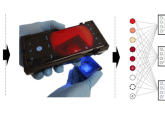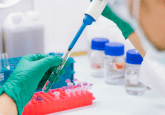Novel electrochemical sensor may be used to develop point-of-care diagnostic device

Chemists at the University of Montreal (Canada) have developed a rapid, inexpensive medical DNA-based diagnostic test, which employs steric effects to detect a wide array of protein markers. Their work may aid efforts to develop point-of-care devices for the quick diagnosis of various diseases, ranging from cancer to sexually transmitted diseases. Their findings were recently published in the Journal of the American Chemical Society.
The key breakthrough for this technology came by chance, explains Sahar Mashshid, post-doctoral scholar at the university and first author of the study: “While working on the first generation of these DNA-based tests, we realized that proteins, despite their small size (typically 1000-times smaller than a human hair) are big enough to run into each other and create steric effect (or traffic) at the surface of a sensor, which drastically reduced the signal of our tests.”.
The sensing principle is reasonably straightforward; the diagnostically relevant protein (green or red) binds to an electro-active DNA strand, this limits the ability of this strand of DNA to hybridize to its complimentary strand located on the surface of a gold electrode. This novel signaling mechanism produces a change in current sufficient enough to be measured by inexpensive electronics, similar to those in glucose meters used by diabetics.
Using the selective and sensitive DNA-based assay, the researchers were able to detect multiple protein markers of diabetes directly in whole blood in fewer than 10 minutes, even with concentrations 1,000,000 times lower than glucose.
The new technology is potentially low cost, easy to use and produces results rapidly, and therefore could drastically impact global health. Alexis Vallée-Bélisle, a Professor in the Department of Chemistry at University of Montreal commented, “Despite the power of current diagnostic tests, a significant limitation is that they still require complex laboratory procedures. Patients typically must wait for days or even weeks to receive the results of their blood tests. If we can move testing to the point-of-care, or even at home, it would eliminate the lag time between testing and treatment, which would enhance the effectiveness of medical interventions.”
The commercial partner of the University of Montreal, Univalor (Canada), has filed a patent application to protect the technology.
Sources: Molecular diagnostics at home: Chemists design rapid, simple, inexpensive tests using DNA. Mahshid SS , Camire S, Ricci F, Vallee-Belsile A. A highly selective electrochemical DNA-based sensor that employs steric hindrance effects to detect proteins directly in whole blood. J. Am. Chem. Soc. doi:10.1021/jacs.5b04942 (2015) (Epub ahead of print).






